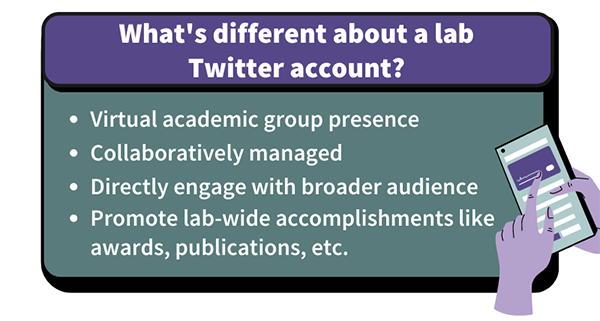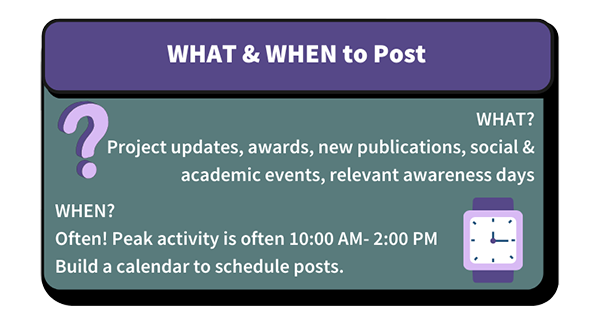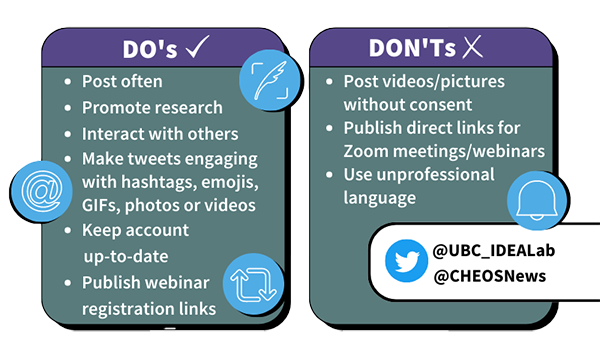Entering the vast realm of social media can seem daunting, but with a little guidance, engaging with the public can be very rewarding. Social media also provides a unique opportunity to engage with the research community, the public, and other knowledge users in an interactive and open space. Wondering how to get started?
CHÉOS Communications and the UBC IDEA (Innovation in Dementia and Aging) Lab want to help get your lab online and have put together several tips and tricks on getting started on Twitter.
Why Twitter?
Scientific writing is a cornerstone of academia. In addition to writing abstracts, papers, and presentations, several funding, project, and award proposals often require a lay summary. Lay summaries succinctly describe a project using language that the public can understand which is material ready to post on Twitter!
Twitter is a text-based social media platform where posts have a limited number of characters (280 to be exact). This format fits quite neatly into the academic space as there is no need to create images or videos in order to post content, although having them available does help. There is also the flexibility of posting several tweets connected with each other in a ‘tweet thread’. The tricky part is to avoid jargon so that the information being shared is easy to understand.
Twitter is also a space that encourages collaboration. It is very easy to comment, share, and interact with others on this platform, whether they be fellow academics, the media, or members of the general public interested in your work. It’s easy to see what others are posting and then direct message them to quickly connect about ideas and opportunities without worrying about getting lost among a sea of emails.

Finally, time is valuable and thankfully, Twitter does not require a high level of time commitment in order to be recognized as active by the social media platform itself. In fact, the 463 million monthly active users only spend an average of 1–2 minutes per day on Twitter. There is also the useful function of scheduling posts in advance, and the notifications tab allows you to efficiently see who’s interacted with your profile and posts and respond immediately.
Get your lab tweeting
Looking for examples of active lab Twitter accounts? CHÉOS Scientist Dr. Lillian Hung is an enthusiastic advocate for knowledge translation, including using social media. Her IDEA Lab, based at the UBC School of Nursing, has a very active Twitter account managed by a couple of lab members. “Our Twitter account is used mainly to engage academic researchers, but we also connect with organizations such as health authorities, research units, universities, and communities,” said Dr. Hung.
Guest author Maddie Ongena is an Integrated Science student who leads the IDEA Lab’s social media initiatives and shares her insights on getting the lab tweeting:

What’s different about a lab Twitter account?
While there are many similarities between a personal account and a lab account, the goal of a lab account is to build an academic presence on Twitter and directly share research with a broader audience. This means posting professional, yet engaging tweets, with a focus on: 1) promoting your lab’s academic accomplishments; 2) keeping the public updated on events; and 3) sharing information about ongoing and upcoming lab projects. Also, one of the benefits of having a lab Twitter account, is that different lab members can log in and contribute, minimizing the overall time commitment to running a social media account. The more people contributing, the better!
 “Our lab Twitter account represents IDEA Lab and seeks to engage academic research activities. We promote students and patient and family partners on the account. My personal account is used to share things such as my dog and my opinion on the world,” said Dr. Hung.
“Our lab Twitter account represents IDEA Lab and seeks to engage academic research activities. We promote students and patient and family partners on the account. My personal account is used to share things such as my dog and my opinion on the world,” said Dr. Hung.
Things to consider
There are a few things to keep in mind before starting up a lab Twitter account, considering that it is part of the public sphere. One of the most important things pertains to confidentiality as you don’t want to release any confidential information about patient or staff partners. Plus, there may be additional staff and site confidentiality considerations to keep in mind. This is especially important when it comes to posting pictures. Always obtain consent prior to posting any photos or videos of other people! Keep in mind that a lab Twitter account is comparable to running a professional account so act accordingly. While it is okay to post fun and exciting tweets, always ensure that you are using appropriate, inclusive language and remaining courteous to others.
Although Twitter is among the least time-consuming of social media outlets, it does still take time. Often, writing tweets takes the longest because crafting a succinct, yet still accurate tweet within the limited character count can be challenging, especially when first starting out. Don’t worry though, practice makes perfect!
It is also possible to schedule posts in advance, which is particularly helpful if you know that an event or announcement is happening on a specific day. In fact, one trick to maintaining accountability is creating a schedule of when to post and possibly scheduling a post or two in advance. This schedule can include the specific days you want to post or simply include the dates of any events or workshops that your lab is participating in. It will serve as a great visual reminder for things you should tweet about, plus pre-scheduled posts can appear when lab members would otherwise be busy.
Other Twitter activities, such as liking, retweeting, or commenting on a post take much less time. These activities are great for showing the algorithm that you are an active user who engages with others and may only take a couple of minutes. The more active your account is, the more exposure it will get. It also allows you to interact, not only with others in academia but also with the general public. “Our key patient partner, Jim, is active on Twitter and he often comments on our posts to amplify our stories,” says Dr. Hung.
Finally, you may be thinking, what can my lab share on Twitter? The good news is that the nature of a lab is to do research and that alone is great content. Come across an exciting paper in your field? Tweet it! A trainee received funding or an award? Tweet it! Speaking at a conference? Tweet it! Lab team-building or holiday activity? Tweet it! Recently published paper? Tweet it! New equipment? Tweet it!

Getting started
The good thing about Twitter is that there are several things you can do to help build your account. One thing that will always be important regardless of your follower count is engagement. Engaging with other Twitter accounts, whether that be re-tweeting, commenting on, or liking posts can be enough to get your account noticed!
Twitter is becoming an increasingly academic platform, so it’s the perfect place to promote various academic-related activities. For example, sharing a new publication is a great way to give your paper and your lab more exposure to the scientific community. Dr. Hung emphasized, “Twitter makes us visible. It draws the public’s attention to the type of research that we do — patient-oriented. The account gives us the opportunity to become influential and it helps us be attuned to what’s going on in the world.”
There is also the opportunity to cross-promote between your website and Twitter, such as embedding a live Twitter feed on the lab website and providing your website link in your Twitter bio. This helps increase internet traffic for both the lab’s Twitter account and website.
Another aspect to focus on is making your tweets engaging, using photos, videos, GIFs, and emojis. People are more likely to stop scrolling if they see an interesting photo or moving image. If there’s a lot of information that needs to be conveyed, maybe consider using a tweet thread that starts with an attention-grabbing photo. The subsequent tweets can include all the important details now that you have your audience’s attention.
One of the benefits of having a lab account is that several different lab members can contribute to it. We recommend being mindful when providing training and support to those that are in posting on Twitter because it is a public-facing representation of the lab. Emphasizing the responsibility and accountability that the lab’s Twitter feed is representative of the whole lab ensures that everyone posting is aware of the potential perception of the lab’s activities by their followers and the general public.
Finally, it’s important that your Twitter account always has up-to-date information. Think of it as a virtual business card that shares your lab’s focus area, academic affiliations, and possibly a link to your lab website. If people are interested in your tweet and want to learn more about your lab, they’ll go to your account for more information. You can even pin a tweet to the top of your lab’s Twitter feed sharing general information about the lab. For example, CHÉOS’ pinned tweet summarizes what the organization does and IDEA Lab’s pinned tweet is often updated with their most recent interactive, online newsletter.
Twitter News
There has been a great deal of media coverage and speculation pertaining to the future of Twitter. Although we are unsure if the platform will remain the industry standard for engaging with audiences, our lab Twitter techniques can also be applied to an up-and-coming platform called Mastodon. Both Twitter and Mastodon function very similarly; however, Mastodon has a slightly different set-up procedure. If you would like to learn more, check out this helpful article.
Want to start a lab Twitter or Mastodon account and need some guidance? Contact our Communications team at communications@cheos.ubc.ca



